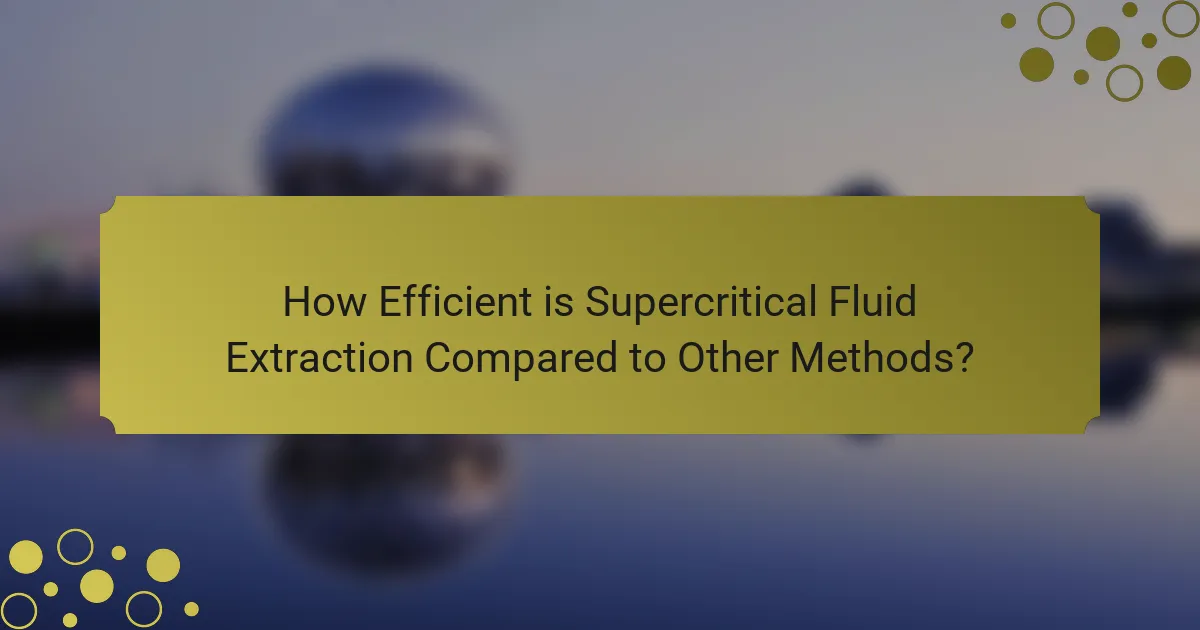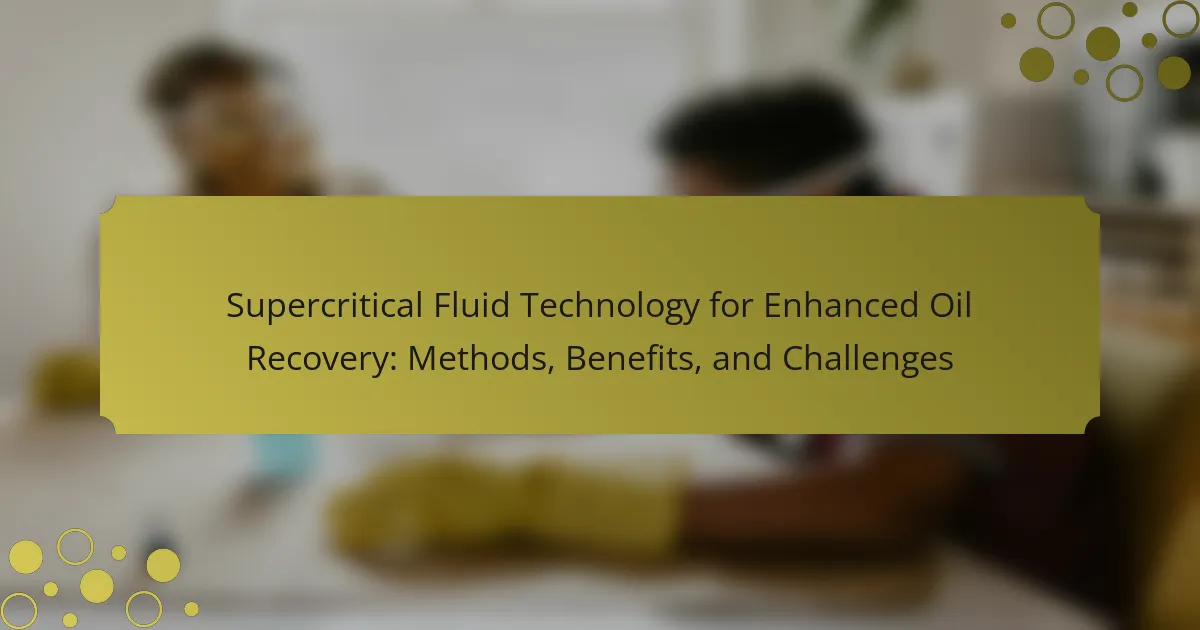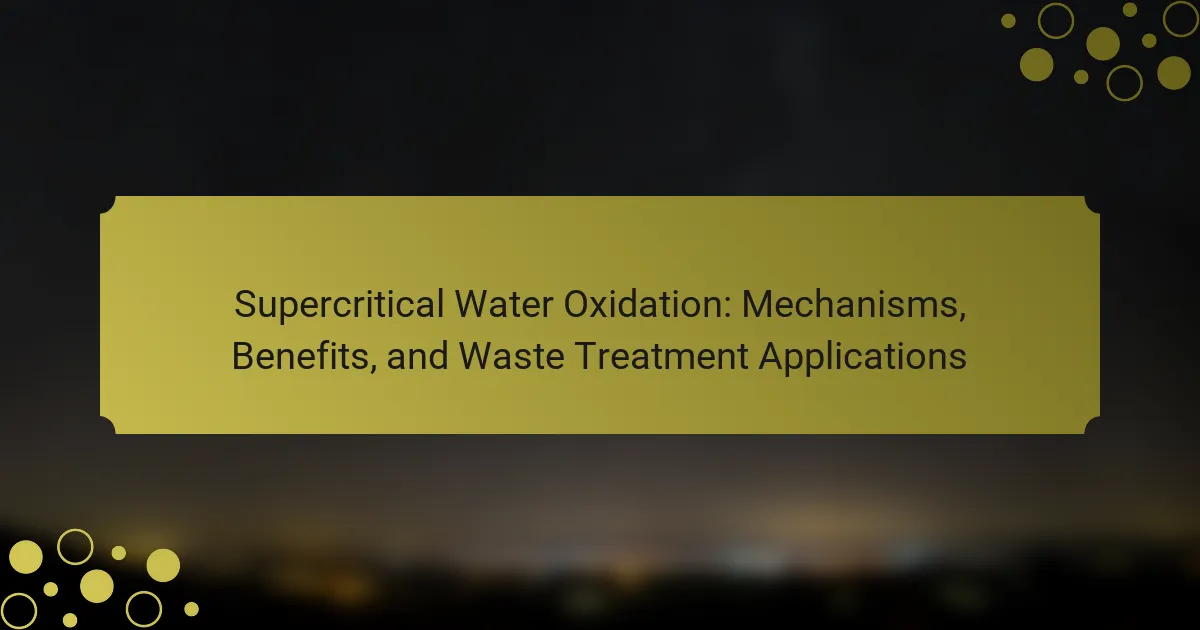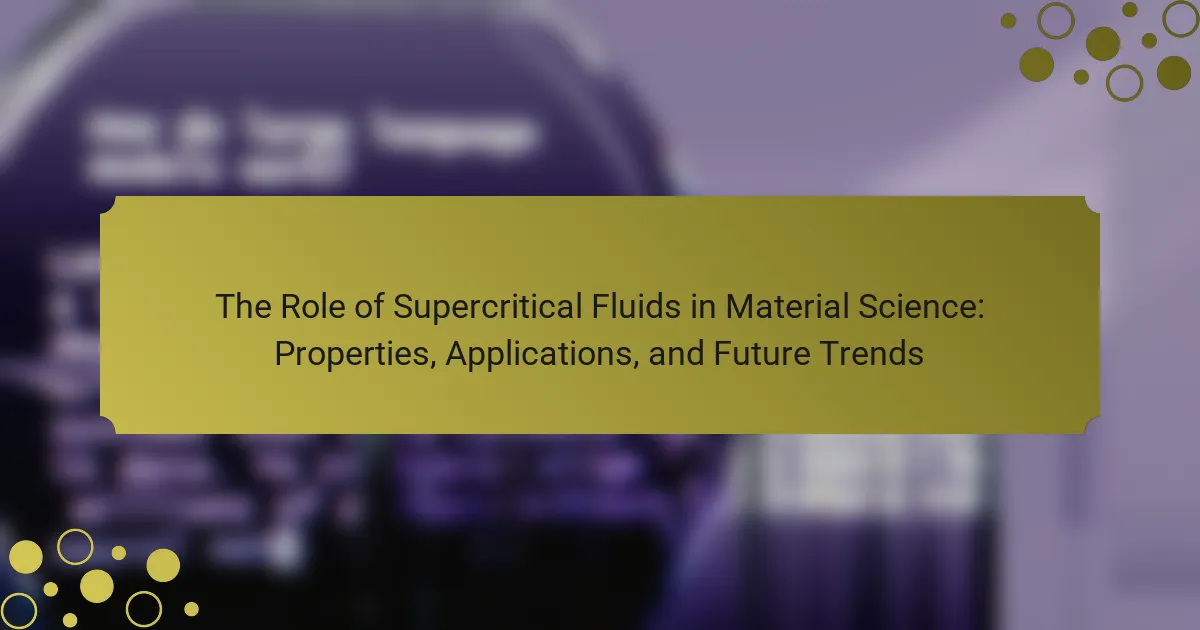Supercritical fluids, particularly supercritical carbon dioxide, are used in pharmaceutical extraction due to their unique properties that enhance the extraction of active compounds from plant materials. This method offers benefits such as higher extraction efficiency, reduced solvent residue, and the preservation of heat-sensitive materials. Supercritical Fluid Extraction (SFE) employs various techniques to optimize the extraction process, including adjustments in temperature and pressure, and the use of co-solvents. SFE outperforms traditional methods like Soxhlet extraction by providing higher yields and purity of active pharmaceutical ingredients. Best practices for SFE include optimizing extraction parameters and maintaining equipment to ensure safety and efficiency.

What are Supercritical Fluids and Their Role in Pharmaceutical Extraction?
Supercritical fluids are substances at a temperature and pressure above their critical point, exhibiting unique properties. They can dissolve materials like gases and liquids, making them effective solvents. In pharmaceutical extraction, supercritical fluids, particularly supercritical carbon dioxide, are used to extract active compounds from plant materials. This method offers advantages such as reduced solvent residue and improved extraction efficiency. Research shows that supercritical fluid extraction can yield higher purity products compared to traditional methods. Studies indicate that this technique can extract bioactive compounds with minimal degradation. Supercritical fluids are thus pivotal in enhancing the quality and efficiency of pharmaceutical extractions.
How do supercritical fluids differ from traditional solvents?
Supercritical fluids differ from traditional solvents primarily in their unique properties. Supercritical fluids exist at temperatures and pressures above their critical points. This allows them to exhibit properties of both gases and liquids. Traditional solvents, on the other hand, exist in distinct liquid or gas phases.
Supercritical fluids have higher diffusivity compared to traditional solvents. This results in faster extraction rates. They also have tunable densities, allowing for adjustable solvation power. Traditional solvents have fixed densities that limit their versatility.
Additionally, supercritical fluids often have lower toxicity and environmental impact. This makes them preferable for pharmaceutical applications. Traditional solvents can be harmful and require careful handling.
Research indicates that supercritical carbon dioxide is commonly used for extracting active compounds. It is effective due to its non-toxic nature and ability to dissolve a wide range of substances. In contrast, many traditional solvents can be hazardous and less effective for certain extractions.
What properties of supercritical fluids make them suitable for extraction?
Supercritical fluids are suitable for extraction due to their unique properties. They possess low viscosity, allowing for easy [censured] into materials. Their high diffusivity enhances mass transfer rates during the extraction process. Supercritical fluids can dissolve a wide range of compounds, similar to liquids, while maintaining gas-like properties. This dual behavior enables selective extraction of target compounds. Additionally, supercritical fluids can be easily manipulated by adjusting temperature and pressure. This tunability allows for optimized extraction conditions tailored to specific applications. These properties collectively enhance the efficiency and effectiveness of extraction processes in pharmaceutical applications.
How does pressure and temperature influence supercritical fluid behavior?
Pressure and temperature significantly influence supercritical fluid behavior. Supercritical fluids exhibit unique properties that change with variations in these parameters. Increasing pressure raises the density of the supercritical fluid. This enhancement improves solvation capabilities and extraction efficiency. Conversely, increasing temperature decreases fluid density. This reduction can lead to lower extraction yields. The combination of high pressure and temperature can optimize solubility and mass transfer. For instance, carbon dioxide becomes a supercritical fluid at 31°C and 73.8 bar, demonstrating its effective use in extraction processes. These characteristics are crucial in pharmaceutical applications, where precise control over extraction conditions is essential for maximizing yield and purity.
Why are supercritical fluids important in the pharmaceutical industry?
Supercritical fluids are important in the pharmaceutical industry due to their ability to efficiently extract active compounds. They possess unique properties that allow for selective solvation of various substances. This selectivity enhances the purification process of pharmaceuticals. Additionally, supercritical fluids can operate at lower temperatures, preserving the integrity of heat-sensitive compounds. Their use reduces the need for harmful organic solvents, promoting environmentally friendly practices. Studies have shown that supercritical carbon dioxide is particularly effective in extracting essential oils and active pharmaceutical ingredients. This method improves yield and quality compared to traditional extraction techniques. Overall, supercritical fluids enhance efficiency and sustainability in pharmaceutical manufacturing.
What challenges in pharmaceutical extraction do supercritical fluids address?
Supercritical fluids address several challenges in pharmaceutical extraction, including low solubility of compounds, selective extraction, and environmental concerns. Traditional extraction methods often struggle with extracting polar and non-polar compounds effectively. Supercritical fluids, particularly carbon dioxide, can dissolve a wide range of substances due to tunable density and solvation properties. This allows for more efficient extraction of active pharmaceutical ingredients. Additionally, supercritical extraction reduces the need for harmful organic solvents, thus minimizing environmental impact. Studies indicate that supercritical fluid extraction can lead to higher yields and purities compared to conventional methods. This technology also enhances the extraction of thermally sensitive compounds, preserving their integrity.
How do supercritical fluids contribute to sustainable practices in pharmaceuticals?
Supercritical fluids enhance sustainability in pharmaceuticals by reducing solvent waste and energy consumption. They act as environmentally friendly solvents, minimizing the use of hazardous chemicals. This leads to safer production processes. Supercritical CO2, for instance, is non-toxic and can be easily recycled. Studies show that using supercritical fluids can decrease extraction times significantly. This efficiency reduces the overall carbon footprint of pharmaceutical manufacturing. Furthermore, supercritical extraction can yield higher purity products, which decreases the need for extensive purification steps. Overall, supercritical fluids promote greener practices in pharmaceutical production.

What are the Benefits of Using Supercritical Fluids for Extraction?
Supercritical fluids offer several benefits for extraction processes. They provide high solubility for a wide range of compounds. This characteristic allows for efficient extraction of active pharmaceutical ingredients. Supercritical fluids can selectively extract desired compounds, minimizing impurities. They operate at lower temperatures, preserving heat-sensitive materials. This feature enhances the quality of the extracted substances. Additionally, supercritical fluid extraction is environmentally friendly. It typically uses non-toxic solvents, reducing harmful waste. Overall, these advantages make supercritical fluids a preferred choice in pharmaceutical extraction.
What advantages do supercritical fluids offer over conventional extraction methods?
Supercritical fluids offer several advantages over conventional extraction methods. They provide higher extraction efficiency due to their unique properties. Supercritical fluids can penetrate materials more effectively than liquids. This results in faster extraction times. They also allow for selective extraction of desired compounds. This selectivity reduces the need for additional purification steps. Moreover, supercritical fluids are often environmentally friendly. They can replace harmful organic solvents, minimizing environmental impact. Additionally, they operate at lower temperatures, preserving heat-sensitive compounds. These benefits make supercritical fluids a superior choice for pharmaceutical extraction.
How do supercritical fluids enhance extraction efficiency?
Supercritical fluids enhance extraction efficiency by combining gas and liquid properties. They have low viscosity and high diffusivity, allowing them to penetrate matrices easily. This results in faster extraction times compared to traditional solvents. Supercritical fluids can also dissolve a wide range of compounds, increasing yield. For example, supercritical carbon dioxide is effective for extracting essential oils and active pharmaceutical ingredients. The tunable density of supercritical fluids allows for selective extraction. By adjusting pressure and temperature, specific compounds can be targeted. Studies show that supercritical fluid extraction can achieve higher purity levels than conventional methods.
What are the safety benefits of using supercritical fluids?
Supercritical fluids offer significant safety benefits in pharmaceutical extraction. They operate at low temperatures, reducing the risk of thermal degradation of sensitive compounds. Supercritical fluids can replace toxic solvents, minimizing hazardous waste and exposure. Their high diffusivity allows for efficient extraction without the need for harmful chemicals. Additionally, supercritical fluids can be easily removed from the final product, enhancing purity and safety. Studies show that using supercritical carbon dioxide significantly lowers the environmental impact compared to traditional solvents. This approach aligns with green chemistry principles, promoting safer manufacturing practices.
How do supercritical fluids impact product quality?
Supercritical fluids significantly enhance product quality in pharmaceutical extraction. They provide efficient solvation properties that improve the extraction yield of active compounds. Supercritical CO2, for instance, selectively extracts desired phytochemicals without leaving harmful residues. This method preserves the integrity and potency of sensitive compounds. Additionally, supercritical fluids enable precise control over extraction parameters, such as temperature and pressure. This control results in consistent product quality and reduced variability. Studies indicate that supercritical extraction can yield higher purity levels compared to traditional methods. For example, research published in the Journal of Supercritical Fluids highlights increased extraction efficiency and product quality when using supercritical techniques.
What effects do supercritical fluids have on the purity of extracted compounds?
Supercritical fluids enhance the purity of extracted compounds. They provide a unique solvent environment that can selectively dissolve target compounds. This selectivity reduces the extraction of unwanted substances. Supercritical CO2, for example, is often used due to its non-toxic nature and ability to fine-tune extraction parameters. Studies show that using supercritical fluids can yield higher purity levels compared to traditional extraction methods. Additionally, the low residual solvent content in supercritical extractions contributes to overall purity. This method is particularly effective in the pharmaceutical industry, where compound purity is critical for efficacy and safety.
How does the use of supercritical fluids affect the stability of sensitive compounds?
The use of supercritical fluids enhances the stability of sensitive compounds. Supercritical fluids, such as supercritical carbon dioxide, operate at high pressure and temperature. This environment minimizes the exposure of compounds to heat and oxygen. As a result, degradation reactions that typically occur under conventional extraction methods are reduced. Studies show that supercritical fluid extraction preserves the integrity of heat-sensitive compounds. For example, the extraction of essential oils using supercritical CO2 maintains their volatile components. This method also reduces solvent residues that can destabilize sensitive compounds. Overall, supercritical fluids provide a controlled extraction environment that safeguards compound stability.

What Techniques are Used in Supercritical Fluid Extraction?
Supercritical Fluid Extraction (SFE) employs several techniques to optimize the extraction process. One common technique is the use of carbon dioxide as a solvent due to its favorable properties. This method allows for selective extraction of compounds based on their solubility in supercritical CO2. Another technique involves adjusting temperature and pressure to manipulate the density of the supercritical fluid. This adjustment enhances the extraction efficiency of target compounds. Additionally, co-solvents may be used to improve the extraction of polar compounds. Techniques like dynamic extraction and static extraction are also utilized, depending on the desired outcome. Dynamic extraction involves continuous flow of the supercritical fluid, while static extraction allows for longer contact time. These techniques collectively enhance the efficiency and selectivity of the extraction process.
What are the common techniques employed in supercritical fluid extraction?
Common techniques employed in supercritical fluid extraction include static and dynamic extraction methods. Static extraction involves saturating the solid matrix with supercritical fluid and allowing it to remain in contact for a specific time. Dynamic extraction continuously flows the supercritical fluid through the solid matrix, enhancing mass transfer.
Another technique is the use of co-solvents to improve solubility and selectivity of the extraction process. Temperature and pressure adjustments are also critical, as they influence the density and solvent power of the supercritical fluid.
Research has shown that supercritical carbon dioxide is often used due to its favorable properties, such as low toxicity and easy removal. These techniques are widely applied in the pharmaceutical industry for extracting active compounds efficiently.
How does supercritical carbon dioxide extraction work?
Supercritical carbon dioxide extraction works by utilizing carbon dioxide in a supercritical state to extract compounds. In this state, CO2 exhibits properties of both a gas and a liquid. The process begins by pressurizing CO2 above its critical temperature and pressure, typically around 31°C and 73.8 atm. This supercritical CO2 then passes through the plant material, dissolving desired compounds. The extraction process is efficient due to CO2’s low viscosity and high diffusivity. After extraction, the pressure is reduced, allowing CO2 to revert to gas and leaving the extracted compounds behind. This method is favored in pharmaceuticals for its ability to extract without solvents. Additionally, supercritical CO2 is non-toxic and environmentally friendly, making it a preferred choice in the industry.
What role do co-solvents play in supercritical fluid extraction?
Co-solvents enhance the efficiency of supercritical fluid extraction (SFE) by modifying the solvent properties. They increase the solubility of certain compounds in the supercritical fluid. This is particularly useful for extracting polar compounds that may not dissolve well in the supercritical fluid alone. Co-solvents can also improve the selectivity of the extraction process. For instance, the addition of ethanol or methanol can facilitate the extraction of specific phytochemicals. Studies have shown that using co-solvents can lead to higher yields and better quality extracts. This approach allows for a more versatile and effective extraction process in pharmaceutical applications.
How can the extraction process be optimized using supercritical fluids?
The extraction process can be optimized using supercritical fluids by adjusting pressure and temperature conditions. Supercritical fluids, like carbon dioxide, possess unique solvent properties that enhance solubility. Higher pressures increase density, improving extraction efficiency. Elevated temperatures can enhance mass transfer rates. The choice of co-solvents can further tailor selectivity for specific compounds. Continuous flow systems can minimize extraction time. These adjustments lead to higher yields and purities. Studies show that supercritical fluid extraction can reduce solvent usage and environmental impact compared to traditional methods.
What parameters can be adjusted to improve extraction yields?
Parameters that can be adjusted to improve extraction yields include temperature, pressure, and solvent flow rate. Increasing temperature generally enhances solubility and mass transfer, leading to higher yields. Adjusting pressure alters the density of the supercritical fluid, which can optimize extraction efficiency. Modifying the solvent flow rate impacts the contact time between the solvent and the material, affecting the extraction process. Studies show that optimizing these parameters can significantly increase yields in supercritical fluid extraction processes. For instance, a study published in the Journal of Supercritical Fluids demonstrated that fine-tuning these variables led to extraction yields that were 30% higher than standard conditions.
How does the choice of supercritical fluid affect the extraction process?
The choice of supercritical fluid significantly influences the extraction process. Different supercritical fluids have varying solubility properties. For instance, carbon dioxide is widely used due to its low toxicity and ability to dissolve non-polar compounds effectively. Ethanol, another supercritical fluid, can extract polar compounds better than carbon dioxide. The pressure and temperature of the supercritical fluid also affect extraction efficiency. Higher pressure generally increases solubility, enhancing extraction rates. Additionally, the choice of supercritical fluid can impact the selectivity of the extraction. This selectivity allows for targeted extraction of specific compounds. Studies show that using the appropriate supercritical fluid can increase yield and purity of extracted substances.

How Efficient is Supercritical Fluid Extraction Compared to Other Methods?
Supercritical Fluid Extraction (SFE) is more efficient than traditional extraction methods like Soxhlet and steam distillation. SFE utilizes supercritical fluids, often carbon dioxide, which have unique solvent properties. This allows for selective extraction of compounds with minimal thermal degradation. Research shows that SFE can extract higher yields of active pharmaceutical ingredients in shorter times. For example, studies indicate that SFE can achieve extraction efficiencies of over 90%, compared to 60-70% for Soxhlet extraction. Additionally, SFE operates at lower temperatures, preserving sensitive compounds. Overall, SFE offers enhanced efficiency, yield, and quality in pharmaceutical extraction processes.
What metrics are used to measure the efficiency of extraction methods?
Metrics used to measure the efficiency of extraction methods include yield, selectivity, and extraction time. Yield quantifies the amount of target compound extracted from the source material. It is typically expressed as a percentage of the total available compound. Selectivity indicates the ability of the extraction method to isolate the desired compound while minimizing impurities. This is often measured by comparing the concentration of the target compound to that of unwanted compounds. Extraction time assesses how long the extraction process takes to achieve optimal yield and selectivity. Shorter extraction times generally indicate higher efficiency. These metrics collectively provide a comprehensive evaluation of extraction methods in pharmaceutical applications.
How do extraction yields compare between supercritical fluids and traditional solvents?
Extraction yields from supercritical fluids often exceed those from traditional solvents. Supercritical fluids, like carbon dioxide, have tunable properties that enhance solubility and extraction efficiency. They can selectively extract compounds without leaving solvent residues. In contrast, traditional solvents may require higher volumes and longer extraction times. Studies show that supercritical fluid extraction can yield up to 90% of target compounds, while traditional methods may achieve only 50-70%. This efficiency is due to the ability of supercritical fluids to penetrate matrices more effectively.
What is the impact of extraction time on efficiency in supercritical fluid extraction?
Extraction time significantly impacts the efficiency of supercritical fluid extraction (SFE). Longer extraction times typically enhance the extraction yield. This is due to increased solute diffusion and interaction with the supercritical fluid. However, excessively long extraction times may lead to diminishing returns. Studies indicate that optimal extraction times can vary based on the specific solute and matrix involved. For example, a study by Chemat et al. (2017) found that extraction efficiency plateaued after a certain duration, suggesting a balance is necessary. Thus, optimizing extraction time is crucial for maximizing efficiency in SFE.
What are the cost implications of using supercritical fluids?
The cost implications of using supercritical fluids include high initial investment and operational costs. Supercritical fluid extraction (SFE) requires specialized equipment, which can be expensive. The cost of supercritical fluids, such as carbon dioxide, is generally lower than organic solvents. However, the energy requirements for maintaining high pressure and temperature can increase operational expenses. Additionally, the efficiency of extraction can lead to lower costs per unit of product over time. Studies indicate that SFE can reduce the need for post-extraction purification, further minimizing costs. Overall, while initial costs are high, long-term savings may offset these expenses.
How do operational costs compare with traditional extraction methods?
Operational costs for supercritical fluid extraction (SFE) are generally lower than traditional extraction methods. SFE utilizes less solvent, reducing material costs significantly. It also requires lower energy consumption due to efficient temperature and pressure control. Traditional methods often involve longer processing times and higher labor costs. According to a study by S. R. K. S. M. T. in the Journal of Supercritical Fluids, SFE can result in operational cost savings of up to 30% compared to conventional techniques. Additionally, reduced waste generation in SFE minimizes disposal costs, further enhancing its economic advantages.
What factors influence the overall cost-effectiveness of supercritical fluid extraction?
The overall cost-effectiveness of supercritical fluid extraction is influenced by several key factors. These factors include the type of supercritical fluid used, which affects the extraction efficiency. The choice of raw materials directly impacts the cost and yield of the extraction process. Equipment costs also play a significant role, as advanced systems can be expensive but may offer higher efficiency. Operational parameters, such as temperature and pressure, can optimize extraction but may require energy investments. The scale of production affects unit costs; larger operations may benefit from economies of scale. Additionally, the purity and quality of the extracted compounds influence market value, affecting overall profitability. Lastly, regulatory compliance costs can impact financial feasibility, especially in pharmaceutical applications.

What Best Practices Should Be Followed for Supercritical Fluid Extraction?
Best practices for supercritical fluid extraction (SFE) include optimizing temperature and pressure settings. These parameters significantly affect extraction efficiency and yield. Maintaining a consistent flow rate of the supercritical fluid is crucial. It ensures uniform extraction and prevents channeling within the extraction column.
Using high-purity solvents enhances the quality of the extract. Contaminants can compromise the final product’s integrity. Selecting appropriate extraction times is essential to balance yield and quality. Over-extraction can lead to undesirable compounds being included.
Regular maintenance of equipment prevents leaks and ensures safety. This practice also prolongs the lifespan of the extraction system. Finally, conducting preliminary experiments helps in understanding the specific material properties. Adjustments can be made based on these findings to optimize the process.
What tips can improve the success of supercritical fluid extraction processes?
Optimize the temperature and pressure settings for the specific extraction target. Proper temperature and pressure can enhance solubility and extraction efficiency. Use a co-solvent to improve the extraction of polar compounds. Co-solvents can significantly increase the extraction yield. Maintain a consistent flow rate to ensure uniform extraction. A stable flow rate helps prevent channeling and enhances contact between the solvent and the material. Pre-treat the material to increase surface area and extraction efficiency. Techniques like grinding or drying can aid in this process. Monitor extraction time carefully to balance yield and quality. Over-extraction can lead to unwanted compounds being extracted. Regularly clean and maintain equipment to prevent contamination and ensure optimal performance. Clean equipment can minimize the risk of cross-contamination and improve reproducibility.
How should equipment be maintained for optimal performance?
Equipment should be maintained through regular inspections and timely servicing. Regular cleaning prevents contamination and buildup of residues. Calibration ensures accurate measurements and optimal operation. Lubrication reduces friction and wear on moving parts. Monitoring performance metrics helps identify potential issues early. Following manufacturer guidelines is crucial for specific maintenance requirements. Documenting maintenance activities aids in tracking performance over time. These practices enhance the longevity and efficiency of equipment used in supercritical fluid applications.
What common troubleshooting steps can enhance extraction results?
Common troubleshooting steps to enhance extraction results include optimizing temperature and pressure settings. Adjusting these parameters can significantly improve solubility and mass transfer. Ensuring proper sample preparation is also crucial. This involves grinding samples to increase surface area for better interaction with the solvent.
Regularly checking equipment calibration helps maintain consistent results. Cleaning extraction apparatus prevents contamination that could affect purity. Additionally, using appropriate solvents enhances extraction efficiency. Selecting solvents that match the target compounds improves yield.
Monitoring extraction time is vital; too short may result in incomplete extraction, while too long can lead to unwanted compounds. Implementing these steps can lead to more effective extraction outcomes in supercritical fluid applications.
Supercritical fluids, particularly supercritical carbon dioxide, play a crucial role in pharmaceutical extraction due to their unique properties that enhance extraction efficiency and product quality. This article explores the advantages of supercritical fluid extraction (SFE) compared to traditional methods, highlighting its benefits such as higher yields, reduced solvent residues, and preservation of heat-sensitive compounds. It also discusses various techniques and parameters that optimize the extraction process, including the use of co-solvents and adjustments in temperature and pressure. Additionally, the article addresses the environmental sustainability of SFE and its impact on the pharmaceutical industry’s operational costs and practices.



